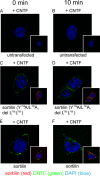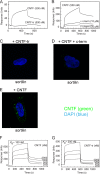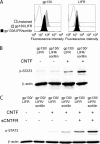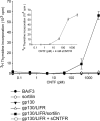Sortilin facilitates signaling of ciliary neurotrophic factor and related helical type 1 cytokines targeting the gp130/leukemia inhibitory factor receptor beta heterodimer
- PMID: 20584990
- PMCID: PMC2937557
- DOI: 10.1128/MCB.00274-10
Sortilin facilitates signaling of ciliary neurotrophic factor and related helical type 1 cytokines targeting the gp130/leukemia inhibitory factor receptor beta heterodimer
Abstract
Sortilin is a member of the Vps10p domain family of neuropeptide and neurotrophin binding neuronal receptors. The family members interact with and partly share a variety of ligands and partake in intracellular sorting and protein transport as well as in transmembrane signal transduction. Thus, sortilin mediates the transport of both neurotensin and nerve growth factor and interacts with their respective receptors to facilitate ligand-induced signaling. Here we report that ciliary neurotrophic factor (CNTF), and related ligands targeting the established CNTF receptor alpha, binds to sortilin with high affinity. We find that sortilin may have at least two functions: one is to provide rapid endocytosis and the removal of CNTF, something which is not provided by CNTF receptor alpha, and the other is to facilitate CNTF signaling through the gp130/leukemia inhibitory factor (LIF) receptor beta heterodimeric complex. Interestingly, the latter function is independent of both the CNTF receptor alpha and ligand binding to sortilin but appears to implicate a direct interaction with LIF receptor beta. Thus, sortilin facilitates the signaling of all helical type 1 cytokines, which engage the gp130/LIF receptor beta complex.
Figures












Similar articles
-
Differential response of neuronal cells to a fusion protein of ciliary neurotrophic factor/soluble CNTF-receptor and leukemia inhibitory factor.Eur J Biochem. 2002 Jun;269(12):3023-31. doi: 10.1046/j.1432-1033.2002.02977.x. Eur J Biochem. 2002. PMID: 12071967
-
The amino acid exchange R28E in ciliary neurotrophic factor (CNTF) abrogates interleukin-6 receptor-dependent but retains CNTF receptor-dependent signaling via glycoprotein 130 (gp130)/leukemia inhibitory factor receptor (LIFR).J Biol Chem. 2014 Jun 27;289(26):18442-50. doi: 10.1074/jbc.M114.568857. Epub 2014 May 6. J Biol Chem. 2014. PMID: 24802752 Free PMC article.
-
The cytokines cardiotrophin-like cytokine/cytokine-like factor-1 (CLC/CLF) and ciliary neurotrophic factor (CNTF) differ in their receptor specificities.Cytokine. 2012 Dec;60(3):653-60. doi: 10.1016/j.cyto.2012.08.014. Epub 2012 Sep 15. Cytokine. 2012. PMID: 22986012
-
The tripartite CNTF receptor complex: activation and signaling involves components shared with other cytokines.J Neurobiol. 1994 Nov;25(11):1454-66. doi: 10.1002/neu.480251111. J Neurobiol. 1994. PMID: 7852997 Review.
-
Interleukin-6 Family of Cytokines in Cancers.J Interferon Cytokine Res. 2024 Feb;44(2):45-59. doi: 10.1089/jir.2023.0103. Epub 2024 Jan 17. J Interferon Cytokine Res. 2024. PMID: 38232478 Review.
Cited by
-
Sortilin participates in light-dependent photoreceptor degeneration in vivo.PLoS One. 2012;7(4):e36243. doi: 10.1371/journal.pone.0036243. Epub 2012 Apr 27. PLoS One. 2012. PMID: 22558402 Free PMC article.
-
Cytokine-Like Factor 1, an Essential Facilitator of Cardiotrophin-Like Cytokine:Ciliary Neurotrophic Factor Receptor α Signaling and sorLA-Mediated Turnover.Mol Cell Biol. 2016 Mar 31;36(8):1272-86. doi: 10.1128/MCB.00917-15. Print 2016 Apr. Mol Cell Biol. 2016. PMID: 26858303 Free PMC article.
-
Exercise-induced CLCF1 attenuates age-related muscle and bone decline in mice.Nat Commun. 2025 May 22;16(1):4743. doi: 10.1038/s41467-025-59959-w. Nat Commun. 2025. PMID: 40399268 Free PMC article.
-
PAK Kinases Target Sortilin and Modulate Its Sorting.Mol Cell Biol. 2020 Jan 16;40(3):e00411-19. doi: 10.1128/MCB.00411-19. Print 2020 Jan 16. Mol Cell Biol. 2020. PMID: 31767632 Free PMC article.
-
Trafficking in Alzheimer's Disease: Modulation of APP Transport and Processing by the Transmembrane Proteins LRP1, SorLA, SorCS1c, Sortilin, and Calsyntenin.Mol Neurobiol. 2018 Jul;55(7):5809-5829. doi: 10.1007/s12035-017-0806-x. Epub 2017 Oct 27. Mol Neurobiol. 2018. PMID: 29079999 Review.
References
-
- Aasland, D., B. Oppmann, J. Grotzinger, S. Rose-John, and K. J. Kallen. 2002. The upper cytokine-binding module and the Ig-like domain of the leukaemia inhibitory factor (LIF) receptor are sufficient for a functional LIF receptor complex. J. Mol. Biol. 315:637-646. - PubMed
-
- Adler, R., K. B. Landa, M. Manthorpe, and S. Varon. 1979. Cholinergic neuronotrophic factors: intraocular distribution of trophic activity for ciliary neurons. Science 204:1434-1436. - PubMed
-
- Alexander, W. S., S. Rakar, L. Robb, A. Farley, T. A. Willson, J. G. Zhang, L. Hartley, Y. Kikuchi, T. Kojima, H. Nomura, M. Hasegawa, M. Maeda, L. Fabri, K. Jachno, A. Nash, D. Metcalf, N. A. Nicola, and D. J. Hilton. 1999. Suckling defect in mice lacking the soluble haemopoietin receptor NR6. Curr. Biol. 9:605-608. - PubMed
-
- Buk, D. M., M. Waibel, C. Braig, A. S. Martens, P. C. Heinrich, and L. Graeve. 2004. Polarity and lipid raft association of the components of the ciliary neurotrophic factor receptor complex in Madin-Darby canine kidney cells. J. Cell Sci. 117:2063-2075. - PubMed
-
- Chang, Y., G. Tesco, W. J. Jeong, L. Lindsley, E. A. Eckman, C. B. Eckman, R. E. Tanzi, and S. Y. Guenette. 2003. Generation of the beta-amyloid peptide and the amyloid precursor protein C-terminal fragment gamma are potentiated by FE65L1. J. Biol. Chem. 278:51100-51107. - PubMed
Publication types
MeSH terms
Substances
LinkOut - more resources
Full Text Sources
Other Literature Sources
Molecular Biology Databases
